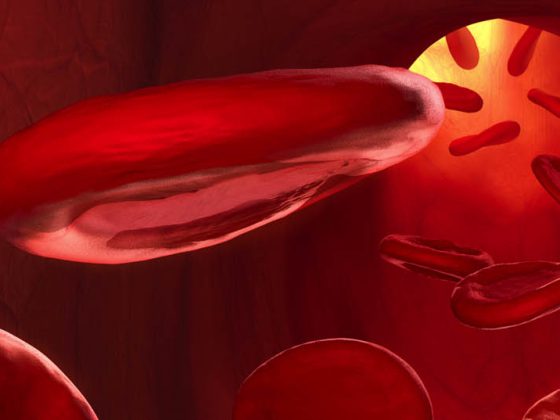On December 11, 2014, diabetes experts from all over Switzerland provided information on current trends and news on diabetes mellitus at a one-day symposium. Outstanding studies published in 2014 were presented. Interest focused on dietary recommendations, weight loss, and the benefits of intensive glucose control.
Dr. med. Fabian Meienberg, University Hospital Basel, spoke on the therapy of type 2 diabetes.
More olive oil – less diabetes
A nutritional study attempted to reduce the risk of type 2 diabetes with a preventive diet [1]. 3500 patients at high cardiovascular risk were randomized to Mediterranean diet with additional olive oil, Mediterranean diet with additional 30 g nuts per day, and control diet with reduced fat consumption. In the olive oil group, 80 people (16%) developed diabetes in about four years, 92 (18.7%) in the nut group, and 101 (23.6%) in the control group. The risk reduction with the olive oil diet compared with the low-fat diet was significant. A high level of evidence was achieved here for a nutrition study. Dr. Meienberg pointed out that a Mediterranean diet is not precisely defined. However, it is not only based on prohibitions, but patients should eat more of certain foods. This increases adherence.
Combination therapy with IDegLira
IDegLira is a new, fixed combination of insulin degludec (Tresiba®) and liraglutide (Victoza®). Safety and efficacy were investigated in a study of 413 type 2 diabetic patients [2]. Study participants received either metformin and insulin degludec or metformin and IDegLira once daily for 26 weeks. The primary endpoint was change in HbA1c. Patients in both groups required the same amount of insulin, but HbA1c was lowered better in the combination group (1.9% vs. 0.9%). In this group, patients lost an average of 2.7 kg, while weight remained stable in the control group. Dr. Meienberg mentioned that in many cases it is possible to avoid or postpone the use of basic bolus insulin therapy by using the combination basic insulin/GLP1 analog.
What are the benefits of bariatric surgery?
Bariatric surgery has become established in recent years not only for weight loss but also for the treatment of type 2 diabetes. In the previous studies, there was only two years of follow-up; with the present study, three years of data have now been presented [3]. 150 patients (mean age 48 years) with uncontrolled type 2 diabetes received intensified medical therapy or Roux gastric bypass resp. A sleeve gastrectomy with optimal diabetes therapy. The mean BMI before study entry was 36. In the operated patients, HbA1c decreased much more in three years than in the conservatively treated patients: 38% (bypass) resp. 24% (sleeve gastrectomy) achieved an HbA1c below 6%, compared with only 5% in the control group. In the surgery group, diabetes medications were also significantly reduced, and patients reported a better quality of life. Four patients required reoperations, but no life-threatening complications occurred. Thus, bariatric surgery shows better results in diabetes control, weight loss, and quality of life than conservative treatment in this patient group.
Intensive glucose control in elderly patients
In the ADVANCE trial, hypertensive combination therapy of perindopril and indapamide was shown to reduce mortality in patients with type 2 diabetes, but intensified glucose control with a target HbA1c below 6.5% did not. In October 2014, the first results of the ADVANCE-ON trial with 8500 patients were published, the follow-up after six years [4]. The survival benefit in patients with blood pressure lowering had diminished five years after the end of the intervention but was still detectable. In contrast, the group with intensive glucose control (HbA1c 6.5% vs. 7.3%) showed no benefit in terms of mortality or macrovascular events.
So, especially in older patients with long-standing diabetes, intensive blood glucose control has little effect. It makes more sense to set the HbA1c individually between 6.5 and 7.5%. “Target blood pressure levels in diabetics remain controversial,” Dr. Meienberg said. “It seems to me that the most important thing is that patients do not have values of 150 or 160 mmHg.”
“Obesity paradox” revisited
Prof. Peter Diem, MD, Inselspital Bern, presented studies with epidemiological data. In one paper, the so-called “obesity paradox” was disproved, which, according to some studies, states that mortality is lower in overweight diabetics than in normal-weight diabetics. This was shown in the study by Tobias et al. but do not comprehend [5]. BMI was followed up for nearly 16 years in more than 11,000 patients with newly detected type 2 diabetes. This showed a J-shaped relationship between BMI and mortality: mortality was higher in very low body weight and in overweight than in normal weight individuals. The authors found no evidence to confirm the “obesity paradox.”
More and more diabetics!
The incidence of diabetes continues to rise in the USA and also in Switzerland – in Denmark, however, the incidence is already declining again. At the same time, the mortality of diabetics has decreased: The lifespan they spend with the disease is becoming longer and longer, and the number of years of life lost is decreasing [6]. For people in the U.S. born between 2000 and 2011, the lifetime risk of diabetes is 40%, and for African American and Hispanic women, the risk is as high as 50. These numbers have important implications for health care delivery and costs.
Lose weight: whether fast or slow is unimportant
Prof. Dr. med. Peter Wiesli, Kantonsspital Frauenfeld, reported on studies dealing with weight reduction. In general, the recommendation is that you should lose weight slowly, because if you lose weight quickly, you would quickly gain it back. Purcell et al. investigated whether this is really true [7]. The study with 200 participants proceeded in two phases: In phase I, a weight loss of 15% was targeted – either in twelve (group 1) or 36 weeks (group 2). All patients who had lost at least 12.5% weight during the corresponding period were followed up in phase II during three years. Three years after weight loss, most participants were back to the same weight as before. The speed of weight loss had no effect on how quickly patients subsequently regained weight. Prof. Wiesli pointed out that rapid weight loss can also have advantages, for example, the rapid success has a motivating effect and the ketogenic metabolic state inhibits hunger.
“Low carb” or “low fat”?
A meta-analysis of diet programs examined which weight loss strategy had the greatest chance of success: “low carb” diets with restricted carbohydrate intake, “low fat” diets with restriction of fat intake, or diets with moderate reduction of all macronutrients [8]. The endpoint assessed was the BMI of participants at six and twelve months. Significant weight loss could be achieved with each type of diet, and the differences between diets in terms of weight reduction were small. Prof. Wiesli summarized the findings from this study as follows: “The best diet is always the one the patient sticks to.”
Source: The year in diabetes 2014, December 11, 2014, Bern
Literature:
- Salas-Salvadó J, et al: Ann Int Med 2014; 160(1): 1-10.
- Buse JB, et al: Diabetes Care 2014; 37(11): 2926-2933.
- Schauer PR, et al: NEJM 2014; 370(21): 2002-2013.
- Zoungas S, et al: NEJM 2014; 371(15): 1392-1406.
- Tobias DK, et al: NEJM 2014; 370(3): 233-244.
- Gregg EW, et al: Lancet Diab Endo 2014; 2(11): 867-874.
- Purcell K, et al: Lancet Diab Endo 2014; 2(12): 954-962.
- Johnston BC, et al: JAMA 2014; 312(9): 923-933.











